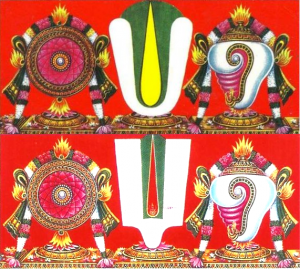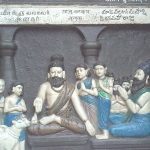How the Śrī Vaiṣṇava Sampradāya separated into the Vaḍagalai and Teṅkalai sects
The Śrī Vaiṣṇava Sampradāya has two major sects, one is called Vaḍagalai and the other Teṅkalai. The two sects have existed for more than 350 years and arose on account of a bitter schism. The foundation of this schism is based on eighteen ideological differences on the topic of mokṣa-dharma propounded by post Rāmānujācārya-era ācāryas Pillailokācārya and Vedānta Deśika during the 1200-1300 AD period.[i] During this period Vedānta Deśika was the first one to detect or disagree with certain works of Pillailokācārya. Maṇavāla Mamuni (Mahāmuni), who appeared right after Vedānta Deśika, primarily subscribed to the doctrines of Pillailokācārya.
The eighteen differences between the two groups of these ācāryas centered on the questions as to who can ultimately award liberation (Lord Nārāyaṇa alone or Mother Lakṣmī as well?) and whether action on the part of the jīva is required in obtaining liberation. Pillailokācārya and his followers maintained the view that liberation can be attained only by the mercy of Lord Nārāyaṇa and not by a jīva’s actions (mārjāra-nyāya – like a kitten relying on a mother cat to lift it and move), whereas, Vedānta Deśika maintained that along with the mercy of Lord Nārāyaṇa, the jīva is required to do his bare minimal devotional activities (markaṭa-nyāya – like a baby monkey holding onto the mother monkey for conveyance). Pillailokācārya propounded that it is not even up to Mother Lakṣmī to influence Lord Nārāyaṇa in the matter of awarding liberation, whereas Vedānta Deśika categorically states that Mother Lakṣmī being the inseparable consort of the Lord also has equal powers to award shelter and liberation.
Differences in Scriptures
Apart from the ideological differences, there were differences of opinion on what śāstras are to be emphasized—Sanskrit Veda or Draviḍa Veda. The Draviḍa Veda (Tamil Veda) is also known as the Nālayira Divya Prabandha, composed by the Ālavāras, who were saints devoted to Lord Viṣṇu and widely revered in South India. The followers of Vedānta Deśika, from Kāncīpuram, northern part of Tamil Nadu, placed more importance on the Sanskrit Vedas as compared to the followers of Pillailokācārya and Maṇavāla Mamuni, from Śrī Raṅgam, southern Tamil Nadu, who placed more importance on the Draviḍa Vedas in their respective fights against the Advaitins and the Śaivaites.
Most of the of present day Śrī Vaiṣṇavas acknowledge that the formal distinguishing features of the schism were established only much later in time (after 1650 CE). Nonetheless, it appears that tensions started to build up right from the periods of the manifest presence of both Pillailokācārya and Vedānta Deśika. The Śrī Vaiṣṇavas in Kāncī, or the northern sect, found it necessary to use the Sanskrit Vedas as their primary weapon for overcoming the Advaitins, who were all experts in Sanskrit. The Śrī Vaiṣṇavas from the South found it necessary to use the Tamil Vedas because they had to deal primarily with Śaivaites, who were expert in the Tamil compositions of the Nāyanmārs, who were also widely revered saints like the Ālavāras but devoted to Lord Śiva.
The Schism
The differences in scripture combined with the differences in ideology between the two groups exacerbated the tensions between them and eventualy drove a deep wedge into the Śrī Vaiṣṇava community, their daily practices of devotional service, temple services, temple rights, privileges, honors, and cultural activities. Śrīman M.A. Venkatakrishnan Swami (Teṅkalai), professor and former head of the department of Vaiṣṇavism, Madras University, Chennai, says that although the ideological differences originated during the 12th and 13th centuries, he believes that the circumstances leading to the formation of the schism were more on superficial issues associated with temple rights, practices, honors, and privileges and were formally established only after 1650 CE. He recollects that around 1650 CE, an incident involving the king of Mysore and the devotees (Teṅkalais) taking care of the Viṣṇu temple at Tirunārāyaṇapuram, Melkoṭe, was the first episode leading to the establishment of the formal schism.
The episode is as follows:
In the 1650’s the Melkoṭe temple was originally managed and controlled by Teṅkalais (Professor M.A.V. Swami agrees that the Vaḍagalais would dispute his claim). The King of Mysore, being dissatisfied with the Teṅkalai devotees of that temple, conferred the rights of temple worship on the other group (Vaḍagalais), who supported the King. The Teṅkalais used to recite the praṇāma mantra of Maṇavāla Mamuni (śri-śaileśa dayā-pātram dhībhaktyādi guṇārṇavam. . .) as part of their temple worship. However, with the transfer of rights to Vaḍagalais, the Vaḍagalais started to recite the praṇāma mantra of Vedānta Deśika (śrī-rāmānuja-dayā-patram jñāna-vairāgya-bhūṣaṇam. . . ) and stopped the recitation of the praṇāma mantra of Maṇavāla Mamuni. This change disturbed the Teṅkalais, and they protested against it.
The King later realized his mistake in interfering with the temple worship and practices, and he then ordered both the praṇāma mantras to be recited as part of the worship. But the followers of Maṇavāla Mamuni and Vedānta Deśika became so alarmed over this incident that to ensure such a thing could never happen in the temples each had control over, they institutionalized their own groups with respect to worship processes and rights. Temples controlled by Teṅkalais followed a process that significantly differed from that of temples under Vaḍagalais. Thus, it was this incident at the Melkoṭe temple that triggered the formalization of the schism between Vaḍagalais and Teṅkalais all over South India, especially in Tamil Nadu.
In order to make their respective sects explicitly different from each other, their ācāryas introduced several variations and differences in their own practices: in the tilak that they wore, the praṇāma mantras that they recited, the choice of reciting Sanskrit Veda versus Divya Prabandham in temples, the number of times they would offer obeisances to the Lord and devotees (Vaḍagalais must offer two, or an even number or more to all, but Teṅkalais would offer only once), and even the first item of mahā-prasādam that they serve to devotees in a feast (Vaḍagalais will first serve ghee and rice whereas Teṅkalais must serve first a salted item such as a sabjī followed by ghee and rice). Among such numerous variations between the two sects, it is still common that staunch members do not enter into marriages with each other or visit each other’s āśramas or temples (certainly not officially).[ii]
(Update: 24 January 2022 – See this link for the author’s comment to this essay.)
End Notes
[i] These 18 differences have been explained in great detail by various spiritual leaders belonging to both the sects. However, a brief summary or outline is available at: http://sriramanujar.tripod.com/tVsv.html
[ii] Within each of the Śrī Vaiṣṇava Vaḍagalai and Teṅkalai sects, two significant subdivisions exist, based on whether the devotees follow āgama śāstra or pāñcarātra śāstra. Those who follow the Āgamas are called Vaikhānasa (The Tirupati Tirumalā temple is Vaikhānasa, the Śrī Raṅgam temple follows Pāñcarātra). The Vaikhānasas do not necessarily follow the Divya Prabandham nor are from the Śrī Vaiṣṇava guru-paramparā coming in the line of Śrī Rāmānujācārya but are recognized as Śrī Vaiṣṇavas nonetheless. The Vaikhānasas follow āgama śāstra because they are descendants of Vikhānasa Muni (the founder-ācārya of the āgama śāstras and an incarnation of Lord Brahmā, who received Vedic knowledge directly from Lord Nārāyaṇa). In addition, Vaikhānasa is acknowledged as bona fide by previous Śrī Vaiṣṇava ācāryas like Vedānta Deśika in Śrī Pāñcarātra-raksā.


Śrīdhara Śrīnivāsa Prabhu, Thanks for you article and very well described “vadagali and tenkalai” is one of the hot topic in south India for agama sastra and pancaratra sastra. Many have different perspectives or we can say speculation especially within Iyengar family in this modern world. Thanks for your effort to brief it out.
Hare Krishna Prabhuji.
Thanks for your appreciation. This article is intended to alert about schisms. How to avoid them is to reconcile or harmonize our views based on sastra-sadhu-guru vakyas. Please see CC Adi 12.8 purport and CC madhya 20.352 purports.
So which one is Vadagalai and which one Tenkalai? It is not clear
The one that resembles a v(u) is vadagalai and the one with T (y) is Tenkalai..
Good point. Could have added that into the article …thanks.
Thank you very much.
Thank you very much. Appreciate your article
The article has detailed information and may benefit the scholars as well as common devotees. Thank you